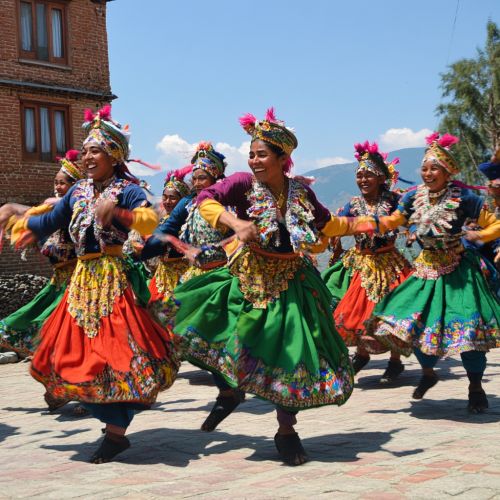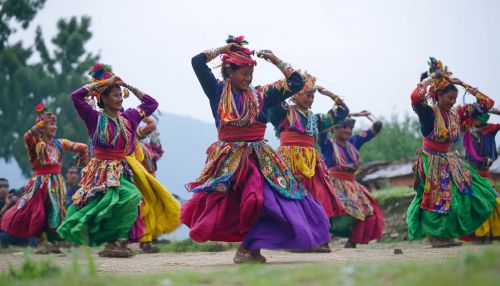Magar
Introduction
The Magar are one of the indigenous ethnic groups of Nepal, primarily residing in the mid-hills of the country. They are known for their rich cultural heritage, unique language, and significant contributions to the history and society of Nepal. This article delves into the various aspects of the Magar community, including their history, culture, language, social structure, and more.
History
The history of the Magar people is deeply intertwined with the history of Nepal. They are believed to be one of the earliest settlers in the region, with their presence dating back to ancient times. Historical records suggest that the Magars played a crucial role in the unification of Nepal under King Prithvi Narayan Shah in the 18th century. They were known for their valor and served as soldiers in the Gorkha army, which was instrumental in the unification process.
Ancient Period
The origins of the Magar people are shrouded in mystery, with various theories suggesting different ancestral roots. Some scholars believe that the Magars migrated from Central Asia, while others suggest that they are descendants of the Mongoloid race. Archaeological evidence and oral traditions indicate that the Magars have been residing in the mid-hills of Nepal for several millennia.
Medieval Period
During the medieval period, the Magars established several small principalities in the western and central regions of Nepal. These principalities were known for their autonomous governance and military prowess. The Magar kings and chieftains maintained their independence until the rise of the Gorkha Kingdom in the 18th century.
Modern Period
In the modern period, the Magars have continued to play a significant role in Nepalese society. They have been actively involved in various social, political, and economic spheres. The Magar community has produced several notable figures in the fields of politics, literature, and the arts.
Culture
The Magar culture is rich and diverse, encompassing various aspects such as festivals, rituals, music, dance, and traditional attire. The Magars have preserved their cultural heritage through generations, maintaining a strong sense of identity and community.
Festivals
The Magars celebrate several festivals throughout the year, with each festival having its unique significance and rituals. Some of the major festivals include:
- **Maghe Sankranti**: This festival marks the beginning of the month of Magh in the Nepalese calendar and is celebrated with various rituals and feasts.
- **Tihar**: Also known as the festival of lights, Tihar is celebrated with great enthusiasm by the Magar community. It involves the worship of various deities, including Laxmi, the goddess of wealth.
- **Dashain**: Dashain is the longest and most significant festival in Nepal, celebrated by the Magars with various rituals, including animal sacrifices and family gatherings.
Music and Dance
Music and dance are integral parts of Magar culture. Traditional Magar music is characterized by the use of various musical instruments such as the madal (a type of drum), flutes, and string instruments. The Magar people have several traditional dances, including the Maruni dance, which is performed during festivals and special occasions.


Traditional Attire
The traditional attire of the Magar people is colorful and distinctive. Men typically wear a daura suruwal (a traditional Nepalese outfit) along with a topi (a type of cap), while women wear a gunyu cholo (a traditional blouse and skirt) adorned with various ornaments.
Language
The Magar language, also known as Magar Kura, is a member of the Sino-Tibetan language family. It is spoken by a significant portion of the Magar population, particularly in the mid-hills of Nepal. The language has several dialects, including the Kham, Kaike, and Dhut dialects.
Linguistic Characteristics
The Magar language is characterized by its unique phonetic and grammatical features. It has a rich vocabulary and a complex system of verb conjugation. The language also has its own script, known as the Magar Akkha, which is used in various religious and cultural texts.
Language Preservation
Efforts are being made to preserve and promote the Magar language, as it is considered an essential aspect of the community's cultural heritage. Various organizations and institutions are working towards documenting and revitalizing the language through educational programs and publications.
Social Structure
The social structure of the Magar community is based on a clan system, with each clan having its own distinct identity and traditions. The Magars have a patriarchal society, with the eldest male member typically serving as the head of the family.
Clans
The Magar community is divided into several clans, each with its own unique customs and traditions. Some of the major clans include:
- **Ale**: The Ale clan is known for its rich cultural heritage and traditional practices.
- **Thapa**: The Thapa clan has a long history of military service and is known for its valor and bravery.
- **Rana**: The Rana clan is one of the most prominent clans in the Magar community, with a significant presence in various social and political spheres.
Marriage and Family
Marriage in the Magar community is typically arranged by the families of the bride and groom. Traditional wedding ceremonies involve various rituals and customs, including the exchange of gifts and the performance of religious rites. The Magars place a strong emphasis on family values and maintain close-knit family ties.
Economy
The economy of the Magar community is primarily agrarian, with agriculture being the main source of livelihood. The Magars practice subsistence farming, cultivating crops such as rice, maize, millet, and barley. In addition to agriculture, the Magars are also involved in animal husbandry, forestry, and various artisanal crafts.
Agriculture
Agriculture is the backbone of the Magar economy. The Magars practice terraced farming on the hillsides, utilizing traditional farming techniques passed down through generations. They grow a variety of crops, including staple grains, vegetables, and fruits.
Artisanal Crafts
The Magars are known for their skills in various artisanal crafts, including weaving, pottery, and wood carving. These crafts are not only a source of income but also an essential aspect of the community's cultural heritage.
Religion
The Magar people follow a mix of Hinduism, Buddhism, and animism. Their religious practices are deeply rooted in their cultural traditions and beliefs.
Hinduism
Hinduism is the predominant religion among the Magars, with various Hindu deities being worshipped in their daily lives. The Magars celebrate several Hindu festivals and observe various religious rituals.
Buddhism
A significant portion of the Magar population also practices Buddhism. Buddhist rituals and festivals are an integral part of their religious life, with many Magars visiting Buddhist monasteries and stupas for worship.
Animism
Animism, the belief in the existence of spirits and supernatural beings, is also prevalent among the Magars. They believe in the presence of various spirits in nature and perform rituals to appease these spirits and seek their blessings.
Contemporary Issues
The Magar community faces several contemporary issues, including challenges related to education, healthcare, and economic development. Efforts are being made to address these issues and improve the overall well-being of the community.
Education
Access to education remains a significant challenge for the Magar community, particularly in rural areas. Various governmental and non-governmental organizations are working towards improving educational facilities and promoting literacy among the Magars.
Healthcare
Healthcare is another critical issue for the Magar community. Limited access to healthcare facilities and services in remote areas poses significant challenges. Efforts are being made to improve healthcare infrastructure and provide better medical services to the Magar population.
Economic Development
Economic development is essential for the overall progress of the Magar community. Various initiatives are being undertaken to promote sustainable economic growth, including the development of infrastructure, promotion of tourism, and support for small-scale industries.
